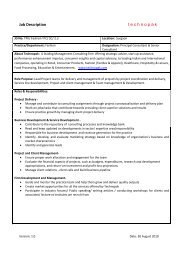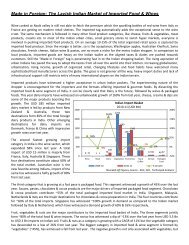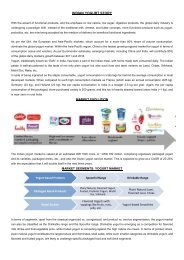The Packaged Juices Market in India - Technopak
The Packaged Juices Market in India - Technopak
The Packaged Juices Market in India - Technopak
Create successful ePaper yourself
Turn your PDF publications into a flip-book with our unique Google optimized e-Paper software.
<strong>The</strong> <strong>Packaged</strong> <strong>Juices</strong> <strong>Market</strong> <strong>in</strong> <strong>India</strong><strong>The</strong> <strong>India</strong>n Fruit <strong>Juices</strong> <strong>Market</strong>With<strong>in</strong> the beverages market, the fruit-based beverages category is one of the fastest grow<strong>in</strong>g categories, andhas grown at a CAGR of over 30% over the past decade. At present, the <strong>India</strong>n packaged juices market is valuedat INR 1100 crore (~USD 200 million) and is projected to grow at a CAGR of ~15% over the next three years.<strong>The</strong> packaged fruit juices market can be divided <strong>in</strong>to three subcategories, viz. fruit dr<strong>in</strong>ks, juices, and nectardr<strong>in</strong>ks. Fruit dr<strong>in</strong>ks, which have a maximum of 30% fruit content, are the highest-sell<strong>in</strong>g category, with a 60%share of the market. Frooti, Jump<strong>in</strong>, Maaza, etc. are the most popular products <strong>in</strong> this category. Fruit <strong>Juices</strong>, onthe other hand, are 100% composed of fruit content, and claim a 30% market share at present. In contrast, nectardr<strong>in</strong>ks have between 25-90% fruit content, but account for only about 10% of the market.<strong>The</strong> ris<strong>in</strong>g number of health-conscious consumers is giv<strong>in</strong>g a boost to fruit juices; it has been observed thatconsumers are shift<strong>in</strong>g from fruit-based dr<strong>in</strong>ks to fruit juices as they consider the latter a healthier breakfast/snackoption.A Competitive LandscapeDabur is the market leader <strong>in</strong> the <strong>India</strong>n packaged juices market with its brands Real and Real Activ. It accountsfor ~55% of the total packaged juices market, and is followed by PepsiCo with a ~30% share. Other players<strong>in</strong>clude Parle, Fresh Gold, and Godrej.Some of the other brands of fruit juices and dr<strong>in</strong>ks <strong>in</strong>clude Frooti, Appy, Mazza, M<strong>in</strong>ute Maid, Slice, Fresh Gold,and Del Monte. Consider<strong>in</strong>g the attractiveness of the segment, such diversified consumer food companies as ITCare work<strong>in</strong>g towards a foray <strong>in</strong>to <strong>Packaged</strong> <strong>Juices</strong>.Preferred Pack sizesAs per studies, the most preferred pack size is the <strong>in</strong>dividual (small) pack which is convenient, and easy to carryand consume. <strong>The</strong>se are <strong>in</strong> great demand as out-of-home consumption is on the rise. Consequently, there is agrow<strong>in</strong>g consumer base, and also <strong>in</strong>tense competition. Tetrapaks are most popular among manufacturers as wellas consumers. Some companies are also offer<strong>in</strong>g their products <strong>in</strong> t<strong>in</strong>s (e.g. Del Monte) and PET bottles (e.g.Mazza); however, they are more expensive than Tetrapaks, which adds to production costs, and, as a result,affects the market price.Fruit juices have created a space for themselves <strong>in</strong> regular household menus, as a part of a family’s breakfast,social gather<strong>in</strong>gs, and even<strong>in</strong>g snacks. As a result, consumers are pick<strong>in</strong>g up multiple family packs at one go,which is an emerg<strong>in</strong>g consumption trend.Growth drivers<strong>The</strong>re are several reasons beh<strong>in</strong>d the growth the <strong>India</strong>n <strong>Packaged</strong> juices category has realized; some of theseare mentioned below. Chang<strong>in</strong>g consumer lifestyles: Given the change <strong>in</strong> eat<strong>in</strong>g habits, the wider global exposure, and thegrow<strong>in</strong>g time-poverty, has provided a fillip to the convenience food segment. Aga<strong>in</strong>, consumerpreferences are shift<strong>in</strong>g towards healthier lifestyles. As a result, the packaged juices market has charteda high growth trajectory thanks to its easy availability, anytime-anywhere consumption, andconvenience. <strong>Juices</strong> are often seen to be quick, yet nutritional, fillers.Increased Health Awareness: <strong>The</strong> ris<strong>in</strong>g awareness about heart- and weight-related health issues,especially among teenagers and young adults, has propelled the consumption of packaged fruit dr<strong>in</strong>ks.<strong>The</strong>re is also a greater preference for these “healthier” beverages than carbonated soft dr<strong>in</strong>ks.Hygiene matters: <strong>Juices</strong> are healthy only when prepared hygienically. <strong>Packaged</strong> juices from trustednational and <strong>in</strong>ternational brands have usually been prepared and certified to be <strong>in</strong> accordance withhealth and safety regulations. <strong>The</strong>y thus underp<strong>in</strong> the confidence of consumers <strong>in</strong> consider<strong>in</strong>g them to
e a healthy and convenient option, as compared to the fresh juices available at local jo<strong>in</strong>ts and streetstalls.Grow<strong>in</strong>g category of <strong>in</strong>formed buyers: <strong>The</strong>re is a grow<strong>in</strong>g category of <strong>in</strong>formed buyers who are ableto dist<strong>in</strong>guish between fruit-based beverages and fruit juices. <strong>The</strong>se consumers are health conscious,highly aware, and have higher disposable <strong>in</strong>come. <strong>The</strong>y have, therefore, led the demand for 100% fruitjuices <strong>in</strong> the past couple of years.Ris<strong>in</strong>g Disposable Incomes: In the past few years, there has been a sharp change <strong>in</strong> the number ofnuclear families, <strong>in</strong> tandem with a surge <strong>in</strong> the number of work<strong>in</strong>g couples, which has led to higherdisposable <strong>in</strong>comes. This has aided the affordability of packaged fruit juices, which are fast replac<strong>in</strong>gfresh, homemade juices and becom<strong>in</strong>g a compulsory item on breakfast tables.Boom<strong>in</strong>g modern retail: <strong>The</strong> dynamics of growth <strong>in</strong> the fruit-based beverage space are attributed tomodern retail and allur<strong>in</strong>g shelf displays which drive impulse purchases.Habitual purchase: <strong>The</strong> trend of consumers evolv<strong>in</strong>g from fruit dr<strong>in</strong>ks <strong>in</strong> bottles to sweetened juices to100% packaged juices has been observed largely <strong>in</strong> the past couple of years. Consumers are buy<strong>in</strong>g <strong>in</strong>greater quantities, for household consumption, and buy<strong>in</strong>g fruit juices is becom<strong>in</strong>g more of a habitualpurchase than a need-based purchase.Introduction to new flavors: To k<strong>in</strong>dle consumers’ <strong>in</strong>terest <strong>in</strong> the category and also to cater to diverseand chang<strong>in</strong>g tastes, fruit juices providers are <strong>in</strong>troduc<strong>in</strong>g new flavors and packag<strong>in</strong>g options.Key ChallengesAmong all challenges, it is difficult to control the cost of production at the price po<strong>in</strong>ts of juices, primarily becauseof ris<strong>in</strong>g food <strong>in</strong>flation. <strong>The</strong> cont<strong>in</strong>uous, year-long supply of raw materials, and the non-stop production of juicesfor the full season, is another production-l<strong>in</strong>ked issue which needs to be managed carefully. Also of vitalimportance is controll<strong>in</strong>g transportation and logistics costs.<strong>Packaged</strong> <strong>Juices</strong> are gradually cement<strong>in</strong>g their place <strong>in</strong> the urban household <strong>in</strong> the metros and Tier I cities;however, replicat<strong>in</strong>g the same success <strong>in</strong> Tier II and Tier III cities is still a struggle as residents <strong>in</strong> these regionsstill prefer fresh juices over packaged ones as they are comparatively cheaper and also <strong>in</strong> sync with thetraditional belief that juices are best consumed freshly pressed. Challeng<strong>in</strong>g and chang<strong>in</strong>g consumers’perspective on value for money, to grab a regular spot <strong>in</strong> the common household basket necessitates anaggressive stance towards improv<strong>in</strong>g consumers’ awareness on the positive attributes of packaged juices andtheir merits over locally available options.OpportunitiesAt the same time, the packaged juices market throws up many opportunities. Some of them are outl<strong>in</strong>ed below:Shift towards 100% juices from sweetened juices: This offers a wide opportunity to exist<strong>in</strong>g andupcom<strong>in</strong>g juices manufactur<strong>in</strong>g companies to spruce up their exist<strong>in</strong>g bus<strong>in</strong>ess and plan as needed forbus<strong>in</strong>ess or capacity expansion.Healthy proposition: it has been observed that consumers are mak<strong>in</strong>g healthy choices <strong>in</strong> their beverageconsumption; therefore, fiber-enriched juices and no sugar juices are more <strong>in</strong> demand. Some new juicevariants claim to have no added sugar; this can be positioned as a health attribute, e.g. “Dry Fruit AppleJuice” by Balan Natural FoodsUnique offer<strong>in</strong>g: Consumers are seek<strong>in</strong>g unique fruit flavors apart from the usual mango, orange, orlime-based fruit juices. Companies <strong>in</strong>toned to identify some of the unique fruit juices that can be offered- “Dry Fruit Apple Juice” for <strong>in</strong>stance, which is much sought after due to the nutritive benefits provided bythe comb<strong>in</strong>ation of dates, figs, rais<strong>in</strong>s, almonds, and apple concentrate.Wider Options: Companies need to offer wider varieties and options for the consumer to choose from,rang<strong>in</strong>g from “mixed” fruit juices to pure, s<strong>in</strong>gle fruit juices to dry fruit juices. Thanks to higher <strong>in</strong>comes,consumers are will<strong>in</strong>g to experiment with variety and pay a premium for such value-added products.
Product extension: <strong>The</strong>re has been some recent product extension, e.g. Tropicana launched TropicanaFruit Powder with no preservatives or artificial flavors, which will be available <strong>in</strong> s<strong>in</strong>gle-serve sachetsand can be made <strong>in</strong>to a full glass of juice simply by add<strong>in</strong>g water.It is appropriate to say that the packaged juices market <strong>in</strong> <strong>India</strong> is still evolv<strong>in</strong>g. As there are many national and<strong>in</strong>ternational brands on the verge of succeed<strong>in</strong>g and expand<strong>in</strong>g further <strong>in</strong>to the field, new entrants can also cash<strong>in</strong> on this opportunity by position<strong>in</strong>g/promot<strong>in</strong>g packaged and bottled fruit juices as part of the consumers’ dailydiet. Simultaneously, it is critical to ensure affordability for consumers, while ma<strong>in</strong>ta<strong>in</strong><strong>in</strong>g the hygienic aspects andquality of products throughout the year.Authored By:Gurb<strong>in</strong>der Kumar (Associate Director, Food services & Agriculture)Reetesh Shukla (Associate Director, Food services & Agriculture)















